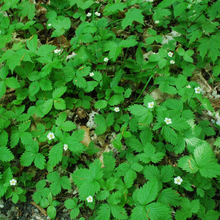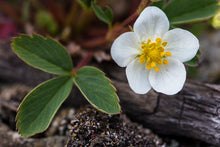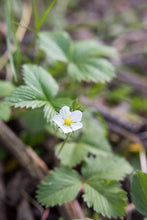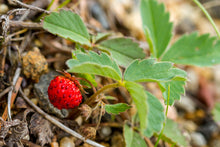
Fragaria virginiana
Wild strawberry is a delightful, semi-evergreen groundcover that will delicately meander through your garden providing habitat for pollinators, beneficial insects, and wildlife. Its blueish-green foliage emerges in early spring, followed by an abundance of crisp white flowers, and eventually tiny, but edible red berries.
- Plant type/canopy layer: deciduous, perennial, herbaceous plant
- Size at maturity: 6-12" tall, 12" wide, spreads by runners to form a continuous groundcover
- Light requirements: full sun. part sun/part shade
- Moisture requirements: moist soil, prefers well-drained
- Bloom time: March - August (April - May in the Portland Metro area)
- Growth rate/ease: fast growing, easy to grow
- Wildlife support: flowers attract and provide nectar for adult butterflies, bees and other insect pollinators; berries eaten by many species of birds and mammals; overall plant attracts and supports beneficial and pest eating insects and is a caterpillar host plant and larval food source for likely dozens of species of native butterflies and moths
- Native habitat/range: commonly found growing in woodland openings, meadows and streambanks across most of the Pacific Northwest (except some areas of Washington's temperate rainforest and high desert). Portland Plant List - yes.
- Special features & uses: semi-evergreen; edible; groundcover; landscape uses include meadowscapes, pollinator gardens, woodland gardens and rock gardens
Gardening with Wild Strawberry: Wild strawberry will find a lovely home in your meadowscape, pollinator garden, rock garden and even the brighter edges of your woodland garden. It spreads readily and effortlessly by runners and seed, quickly creating a groundcover in mostly sunny habitat areas. It is such a delicate and lovely plant, that you will likely rejoice (rather than regret) its vigor and readily share it with friends and neighbors. Though it thrives in acidic, moist soils, it also tolerates summer drought. But, if planted in the hottest, most exposed areas of your yard, it will require infrequent supplemental watering in summer (deeply/infrequently is always best). The berries are edible and mildly sweet, but only the most diligent and astute gardeners will beat backyard inhabitants to the prize. Prune the runners regularly if you would like to encourage larger, more delectable berries.
Photo Credit 1: "Wild Strawberry (Fragaria virginiana)" by wackybadger is licensed under CC BY-SA 2.0.
Photo Credit 2: "Strawberry - Fragaria virginiana" by GlacierNPS is marked with Public Domain Mark 1.0.
Photo Credit 3: "Wild strawberry (Fragaria virginiana)" by YellowstoneNPS is marked with Public Domain Mark 1.0.
Photo Credit 4: "Wild Strawberry - Fragaria virginiana" by Rocky Mountain National Park is licensed under CC BY-ND 2.0







